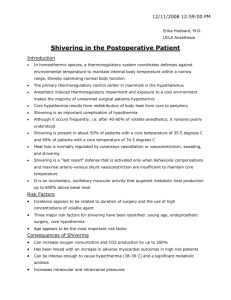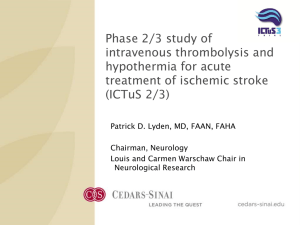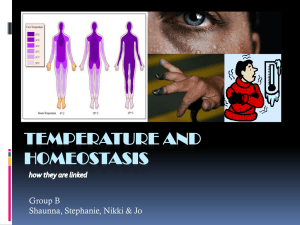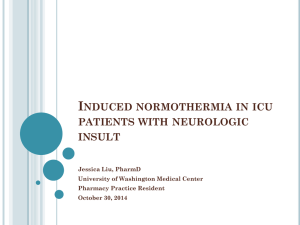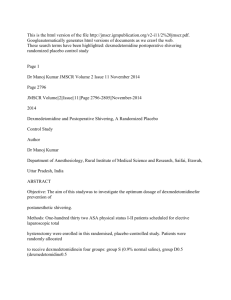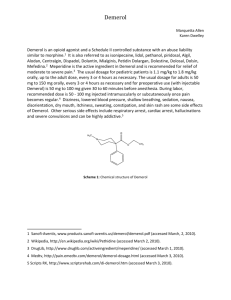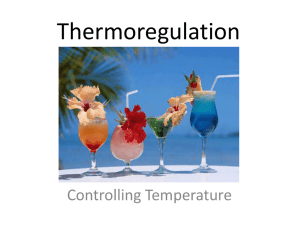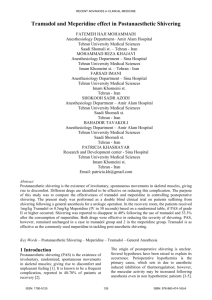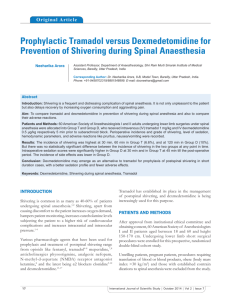Therapeutic Hypothermia
advertisement
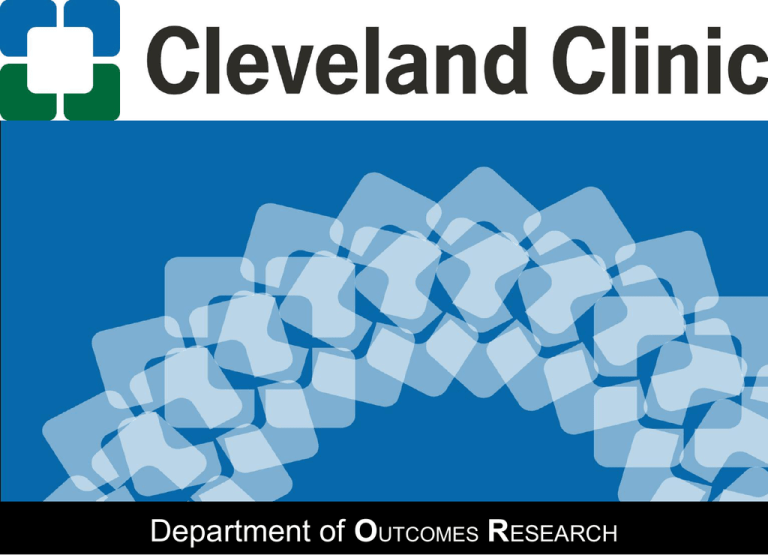
Department of OUTCOMES RESEARCH Defeating Thermoregulatory Defenses Daniel I. Sessler, M.D. Michael Cudahy Professor and Chair Department of OUTCOMES RESEARCH The Cleveland Clinic No conflicts related to this presentation www.OR.org Defeating Thermoregulatory Defenses Temperature monitoring Hypothermia benefits & risks Normal thermoregulation Anesthetic-induced inhibition Other drugs Drug combinations www.OR.org Temperature Monitoring Core Sites • Pulmonary artery • Distal esophagus • Nasopharynx • Tympanic membrane thermocouple Other generally-reliable sites • Mouth • Axilla • Bladder Sub-optimal • Forehead skin • Infrared “tympanic” • Infrared “temporal artery” • Rectal Anesth Analg 2008 Potential Benefits of Mild Hypothermia 33-35°C ameliorates ischemia in animals Decreased tissue metabolism contributes • But is not a major factor Other potential mechanisms • Reduced calcium influx and release of glutamate – Reduced activation of the neuroexcitatory cascade – Decreased apoptosis • Reduced free-radical production • Maintenance of vascular permeability and BBB • Reduced clotting in response to micro-thrombi • Suppression of pro-inflammatory cytokines Evidence in Humans Improves neurologic outcome after cardiac arrest • Bernard, et al. and Hypothermia Study Group • Now recommended by European and American Heart Associations • Number needed to treat: ≈6 Improves neurologic outcome in asphyxiated neonates • Shankaren, et al.; Gluckman, et al.; Eicher, et al. • Number needed to treat: ≈6 No benefit in major human trials • Brain trauma: Clifton, et al. • Anurysm surgery: Todd, et al. • Acute myocardial infarction: Dixon, et al Stroke • Essentially untested Myocardial Outcomes: n=300 Core Temp (°C) Myocardial Events (%) Normothermic Hypothermic P 36.7 ± 0.1 35.3 ± 0.1 <0.001 2 7 0.04 Frank, et al., JAMA, 1997 That hypothermia causes myocardial ischemia was confirmed by Nesher, et al, Ann Thorac Surg, 2001 Blood Loss Normothermia reduced blood loss 22% (95% CI 3-37%, P = 0.027) Transfusion Requirement 22% less blood loss (95% CI 3-37%, P = 0.03) Surgical Wound Infections: n=200 N ormothermic H ypothermic P Temperature 36.6 ±0.5 34.7 ±0.6 <0.001 I nfections (%) 6 19 <0.01 12.1 ±4.4 14.7 ±6.5 =0.001 H ospitalization (days) Three-fold reduction in infection risk from local or systemic warming confirmed by Melling, et al., Lancet, 2001 Normal Thermoregulation Sweating Active vasodilation 37 Vasoconstriction 36 Shivering Regulation Impaired in the Elderly 37 36 Shivering Threshold (°C) 35 34 40 60 80 Age (yr) 100 20% Contribution of Skin Temperature 38 Core Temperature (°C) Vasoconstriction 36 Shivering 34 30 34 38 Skin Temperature (°C) Non-pharmacologic Approaches Core temp tightly controlled • Less controlled age >80 years Skin temp contributes 20% • 4°C skin warming permits 1°C of core cooling • 4°C skin cooling raises defended core temp 1°C Endovascular cooling • Provokes less response than surface cooling • Combine with surface warming for best results Anesthesia Impairs Regulation 39 Sweating 37 Vasoconstriction Threshold 35 (°C) 33 Shivering 31 0 0.5 0.8 Desflurane (MAC Fraction) Opioids Impairs Regulation 38 37 Threshold (°C) 36 35 34 0 100 200 300 [Total Alfentanil] (ng/ml) Meperidine: Special Anti-Shiver Effect 38 Sweating 36 Threshold (°C) Vasoconstriction 34 Shivering 32 0.1 0.3 0.5 [Meperidine] (µg/mL) What’s Special About Meperidine? A “dirty” drug Kappa activity? • Most other commonly used opioid are pure µ agonists • Meperidine has both µ and kappa activity Anti-cholinergic effect? Central alpha-2 agonist? • Effective treatment for postoperative shivering No Special Effect of Nalbuphine 38 Sweating Temp. (°C) Vasoconstriction 36 Shivering 34 0.0 0.2 0.4 Nalbuphine (µg/ml) 0.6 Atropine Increases Thresholds 39 Sweating (°C) * 39 * 38 38 37 37 36 36 37 Shivering (°C) 140 * 36 Vasoconstriction (°C) HR (bpm) * 120 100 80 35 60 40 34 Control Atropine Control Atropine Dexmedetomodine: Special Effect? Sweating 37 Constriction Threshold (°C) 36 35 Shivering 34 0.0 0.2 0.4 0.6 0.8 [Dexmedetomidine] (ng/ml) Drug Combinations Single non-anesthetic drugs insufficient Drug combinations • Possibly increase efficacy – Especially with additive or synergistic interactions • Potential reduction in side-effects Drugs of particular interest • Meperidine • Buspirone: serotonin 1A partial agonist • Dexmedetomidine: central alpha-2 agonist Dexmedetomidine & Meperidine 0.0 -0.5 D Shivering Threshold (°C) -1.0 -1.5 -2.0 -2.5 -3.0 Dex Mep Combo Dex+Mep Buspirone & Dexmedetomidine 0.0 -0.5 -1.0 D Shivering Threshold (°C) -1.5 -2.0 -2.5 -3.0 -3.5 Bus Dex Combo Bus + Dex Buspirone & Meperidine Synergy 36 35 Shivering Threshold (°C) 34 33 32 Control Buspirone Combination Meperidine Recommendations Powerful drugs needed to induce thermal tolerence • Surface cooling provokes thermoregulatory defenses • Combine endovascular cooling and skin warming Use additive or synergistic drug combinations of effective drugs • Additive: meperidine & dexmedetomodine • Additive: buspirone & dexmedetomodine • Synergistic: buspirone & meperidine Best combinations • Reduce shivering threshold ≈2°C • Clinical effect totals ≈3°C when combined with skin warming Beware of complications: MI, coagulapathy, infection Department of OUTCOMES RESEARCH Skin Warming Facilitates Hypothermia Nefopam: Isolated Anti-shivering Action 38 37 Threshold (°C) 36 35 34 0 25 50 75 [Nefopam] (ng/ml) 100 Nefopam & Clonidine P=0.034 0.5 0 D Shivering Threshold (°C) -0.5 -1 -1.5 -2 -2.5 -3 Nefopam Clonidine Combi1 Nef & Clo Nefopam & Meperidine 0.5 P<0.001 0 D Shivering -0.5 Threshold -1 (°C) -1.5 -2 -2.5 -3 Nefopam Meperidine Combi2 Nef & Mep Nefopam & Alfentanil 0 P=0.55 -0.5 D Shivering Threshold (°C) -1 -1.5 -2 -2.5 -3 Nefopam Alfentanil Combi3 Nef & Alf Drug Combination Summary Nefopam & • Clonidine • Meperidine • Alfentanil antagonistic antagonistic additive Dexmedetomidine & • Meperidine • Clonidine • Buspirone Meperidine & buspirone additive additive additive synergistic
